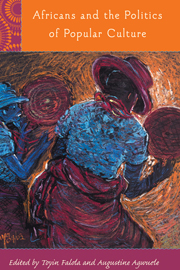Book contents
- Frontmatter
- Contents
- List of Illustrations
- Preface
- Introduction
- 1 From Primitive to Popular Culture: Why Kant Never Made It to Africa
- Part One Politics of Culture in Habitual Customs and Practices
- 2 Popular Culture of Yoruba Kinship Practices
- 3 Justice from Below: Cultural Capital, Local/Global Identity Processes, and Social Change in Eastern Niger
- 4 Popular Culture and the Resolution of Boundary Disputes in the Bamenda Grasslands of Cameroon
- 5 Reverse Mission or Asylum Christianity? A Nigerian Church in Europe
- 6 Performing Pop Tradition in Nigeria: From Yorùbá Bàtá to Bàtá Fújì
- Part Two Politics of Culture in Popular Representations: Films and Performances
- Part Three Politics of Culture in Popular Texts
- List of Contributors
- Index
- Rochester Studies in African History and the Diaspora
3 - Justice from Below: Cultural Capital, Local/Global Identity Processes, and Social Change in Eastern Niger
from Part One - Politics of Culture in Habitual Customs and Practices
Published online by Cambridge University Press: 12 September 2012
- Frontmatter
- Contents
- List of Illustrations
- Preface
- Introduction
- 1 From Primitive to Popular Culture: Why Kant Never Made It to Africa
- Part One Politics of Culture in Habitual Customs and Practices
- 2 Popular Culture of Yoruba Kinship Practices
- 3 Justice from Below: Cultural Capital, Local/Global Identity Processes, and Social Change in Eastern Niger
- 4 Popular Culture and the Resolution of Boundary Disputes in the Bamenda Grasslands of Cameroon
- 5 Reverse Mission or Asylum Christianity? A Nigerian Church in Europe
- 6 Performing Pop Tradition in Nigeria: From Yorùbá Bàtá to Bàtá Fújì
- Part Two Politics of Culture in Popular Representations: Films and Performances
- Part Three Politics of Culture in Popular Texts
- List of Contributors
- Index
- Rochester Studies in African History and the Diaspora
Summary
Introduction
Lougou and Bagagi are two villages marked by the survival of the traditional Azna culture and religion in Hausa-speaking eastern Niger. Sarraounia in the Hausa language means “queen” or female chief but may designate various more or less minor functions of female leadership when written with a lower case s. More significantly, this title refers, in the specific context of our field enquiry and of Niger's recent history, to the functions of the priestesschief of Lougou. Lougou, village of the Sarraounias, is situated in one of the relatively densely populated zones of Niger, part of the eastern Hausa-speaking region sometimes referred to as Mawri country (le pays mawri), which well into the twentieth century, and indeed until recently was known for its unswerving faithfulness to the traditional Azna religion. It is also noted for its opposition to Islam, from the Fulani jihads in precolonial times to the early postindependence era. The title Sarraounia refers, in particular, to a line of descent of women from whom was selected the female leader who exercised both noncentralized political power and religious authority. This religious authority has long become the only remaining—and contested—prerogative of the Sarraounia. Currently, Lougou and its seven allied villages represent the last, impoverished bastions of this once prosperous female chieftaincy. Similar vestiges exist in neighboring regions of eastern Niger and northern Nigeria, where functions like those of the Magaram, Magajiya, Iya or Inna, and Jekadiya persist in more or less vibrant forms.
- Type
- Chapter
- Information
- Africans and the Politics of Popular Culture , pp. 64 - 83Publisher: Boydell & BrewerPrint publication year: 2009



